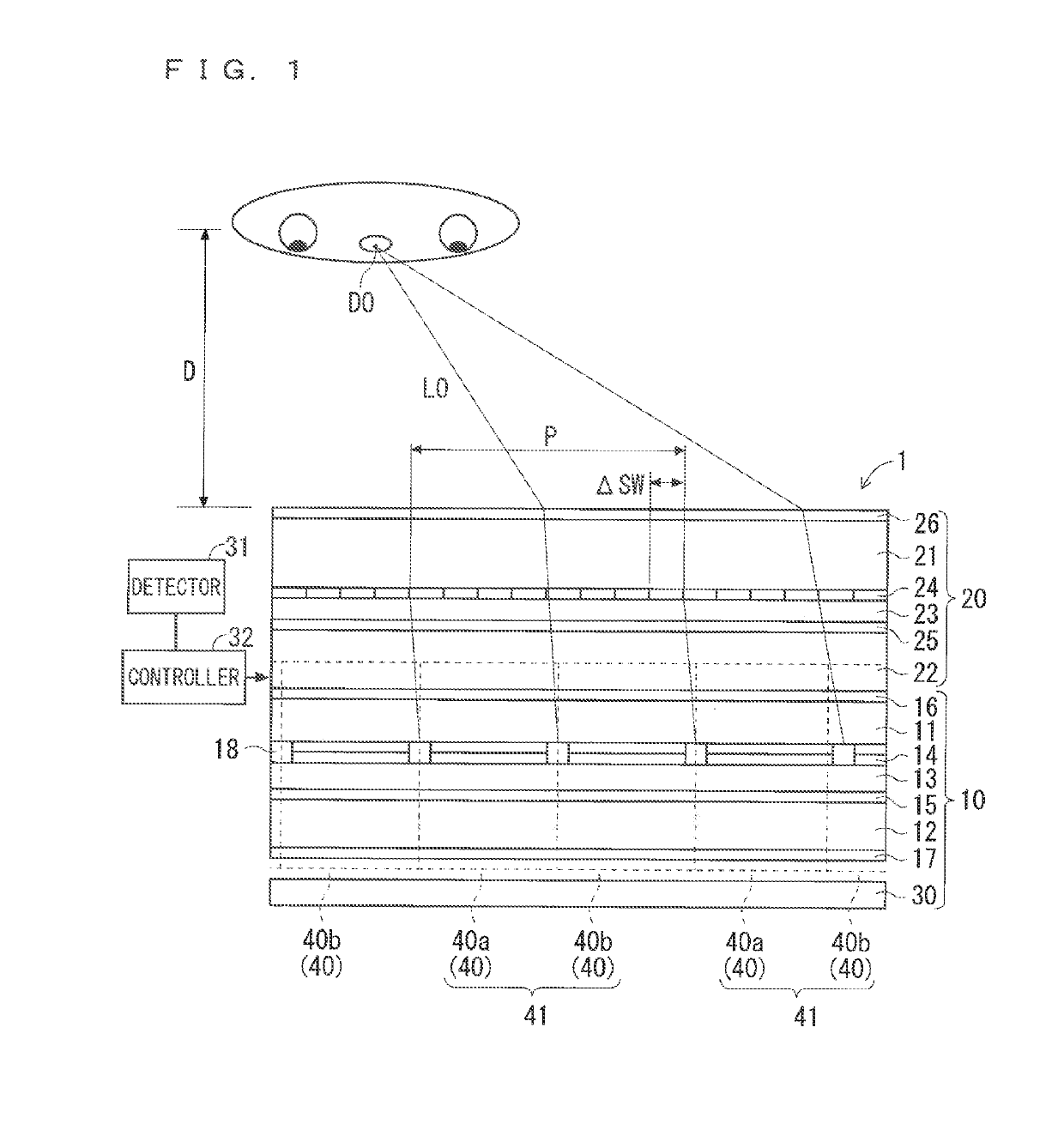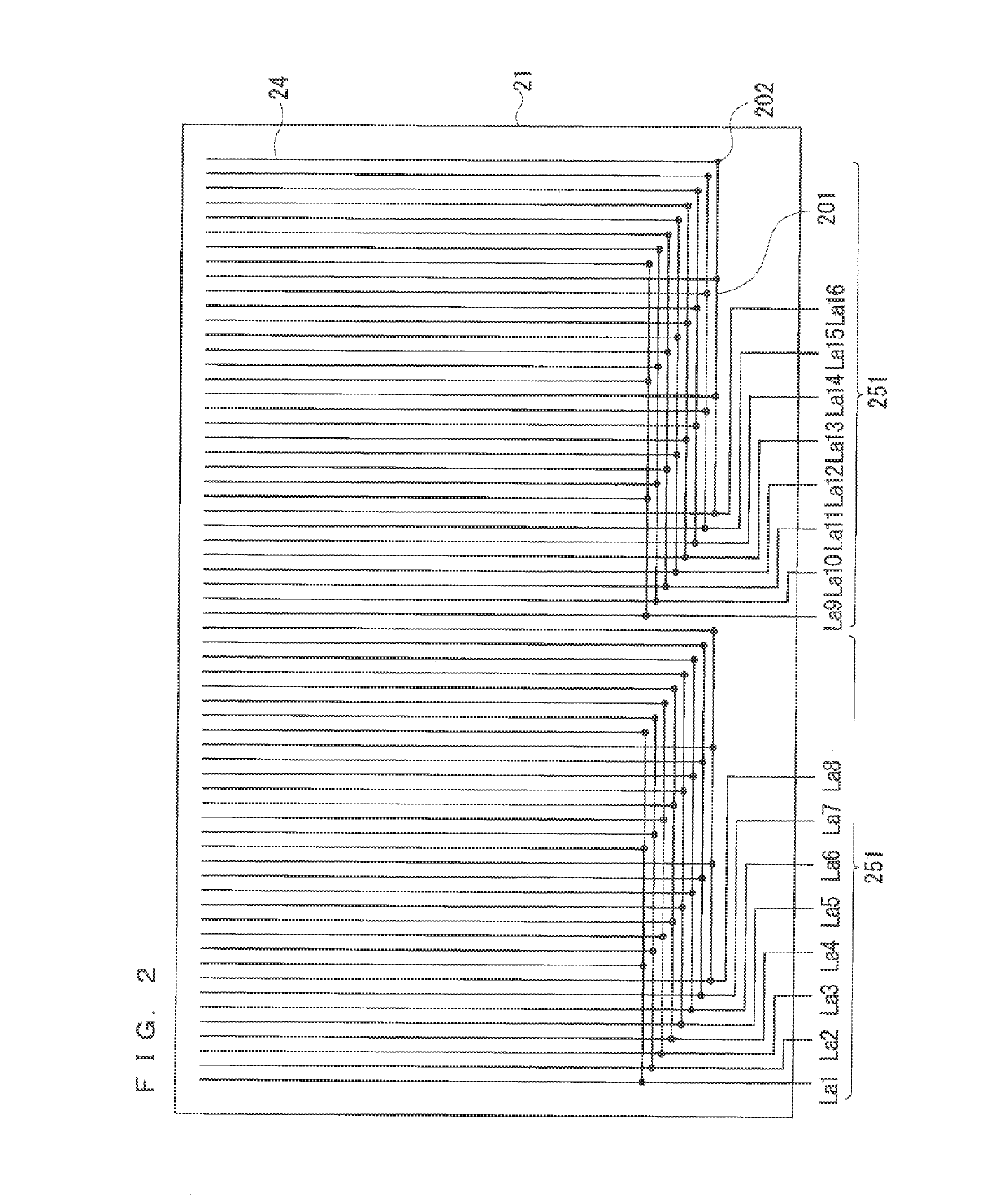Image display device
a stereoscopic image and display device technology, applied in optics, instruments, electrical equipment, etc., can solve the problems of higher risk of disconnection in the transparent electrode, defective panels in which the parallax barrier does not operate correctly, and sense of discomfort in the observer, so as to reduce defectiveness, narrow the width of the sub-aperture, and suppress the increase of the frame area
- Summary
- Abstract
- Description
- Claims
- Application Information
AI Technical Summary
Benefits of technology
Problems solved by technology
Method used
Image
Examples
first preferred embodiment
[0068]The overall configuration of an image display device 1 according to a first preferred embodiment of the present invention is similar to that of FIG. 1. Although not shown in FIG. 1, the image display device 1 of the first preferred embodiment has a different feature from the above underlying technology in the structure of a first transparent substrate 21 of a parallax barrier shutter panel 20. Therefore, the configuration of the first transparent substrate 21 in particular will be described in this preferred embodiment. The configuration of a second transparent substrate 22 may be the same as that of the underlying technology. Here, a second transparent electrode 25 is formed across the entire surface of the second transparent substrate 22.
[0069]Further, in this preferred embodiment, the number of sub-apertures 200, i.e., the number of first transparent electrodes 24, to be provided within a reference parallax barrier pitch P is eight, Note that, the number of sub-apertures 20...
second preferred embodiment
[0107]FIG. 16 is a plan view illustrating an overall configuration of the first transparent substrate 21 of the parallax bather shutter panel 20 according to a second preferred embodiment. FIG. 17 is a partial enlarged plan view of the counter-input-side connection area 56 of the first transparent substrate 21 of the parallax barrier shutter panel 20 according to the second preferred embodiment. FIG. 18 is a cross-sectional view taken along the line F-F illustrated in FIG. 17.
[0108]As illustrated in FIG. 6 and FIG. 9, in the counter-input-side connection area 56 according to the first preferred embodiment, the first transparent electrodes 24 (the lower-layer transparent electrodes 24a and the upper-layer transparent electrodes 24b) that receive input of the same barrier control signal are electrically connected one another via the common wires 204. In contrast, in the second preferred embodiment, as in FIG. 16 and FIG. 17, the first transparent electrodes 24 (the lower-layer transpa...
third preferred embodiment
[0119]FIG. 23 is a plan view illustrating an overall configuration of the first transparent substrate 21 of the parallax barrier shutter panel 20 according to a third preferred embodiment. FIG. 24 is a partial enlarged plan view of the counter-input-side connection area 56 of the first transparent substrate 21 of the parallax barrier shutter panel 20 according to the third preferred embodiment.
[0120]In the above second preferred embodiment, the common wires 204 disposed in the counter-input-side connection area 56 are not connected to any of the first transparent electrodes 24 (the lower-layer transparent electrodes 24a and the upper-layer transparent electrodes 24b) so as to be floated. In the third preferred embodiment, however, at least one first transparent electrode 24 is connected to each common wire 204.
[0121]The first transparent electrodes 24 that are connected to different common wires 204 receive input of different barrier control signals. Thus, each common wire 204 is su...
PUM
 Login to View More
Login to View More Abstract
Description
Claims
Application Information
 Login to View More
Login to View More - R&D
- Intellectual Property
- Life Sciences
- Materials
- Tech Scout
- Unparalleled Data Quality
- Higher Quality Content
- 60% Fewer Hallucinations
Browse by: Latest US Patents, China's latest patents, Technical Efficacy Thesaurus, Application Domain, Technology Topic, Popular Technical Reports.
© 2025 PatSnap. All rights reserved.Legal|Privacy policy|Modern Slavery Act Transparency Statement|Sitemap|About US| Contact US: help@patsnap.com



